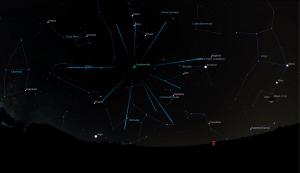
Quadrantid Meteor Shower 2025
- Where:
- Frosty Drew Observatory and Science Center
- When:
- Fri, Jan 3, 2025 7:00 pm - 10:00 pm
- Cost:
- $5 Suggested Donation per Person
The Quadrantid Meteor Shower is one of the best (if not the best) meteor shower of the year. Quite a lively display, the Quadrantides can produce upwards of 120 meteors per hour during the peak when the Moon is not present. Most meteors are typically bright with a greenish hue, many of which are fireball meteors. The 2025 showing will bring the 16% waxing crescent Moon, which will set at 8:44 pm, allowing for fabulous conditions to observe the meteor display. Unlike other meteors showers, the Quadrantid peak is quite brief, lasting about 3-6 hours in duration. Peak times for the Quadrantid shower are tricky to predict and could fall during daylight hours.
The Quadrantid Meteor Shower has a very brief peak period, lasting only 3-6 hours in duration. Timings of the peak period have a significant impact on how awesome the shower will be. The radiant point of the shower, the defunct constellation Quadrans Muralis, is located in between the handle of the big dipper and the constellation Bootes. This region of the sky sits on the north horizon at 8:00 pm for our location, and will ride the NNE horizon until about 9:30 pm. The higher in the sky the radiant point the better the shower.
Unfortunately, predictions for the 2025 Quadrantids place the peak at 12:30 pm EST. This prediction places the entire peak during daytime hours. Peak predictions are difficult and we have seen errors in the past. Regardless, it will be unlikely that a fabulous Quadrantid display will occur this year.
Temperatures will be cold so be sure to dress warm! Winter coats, long johns, thick socks, hat, gloves, good winter shoes, and blankets (while observing meteors) are a necessity. Be sure to bring a blanket to lay on or a reclining chair for optimal meteor observation.
Take a minute to read up on visiting the Frosty Drew Observatory and catch up on what to / not to bring and how to adequately prepare for a comfortable nigh of meteor watching.
Please note that we do not allow any white lights on our campus or in Ninigret Park from dusk - dawn, with the exception of low beam headlights while in motion. This is to ensure an equally awesome view of the night sky for all and to allow for the use of light sensitive astronomical equipment. Learn more about why we have this requirement in The Red Light District.
Grab those binoculars, dust off that telescope, and join us under the beautiful dark skies at Frosty Drew Observatory and kick off the year with the Quadrantids!


